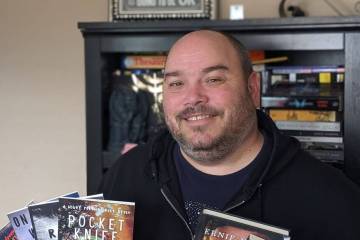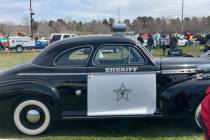All pesticides lethal to bees
Q. I followed some advice on applying a pesticide to kill borers in my fruit trees and now I learned I am killing the bees.
A. All pesticides are lethal to bees. Even soap and water kills them. Soap and water is what is used to kill bees when they have invaded home walls, block walls or irrigation boxes. Never spray any plant with anything that is in flower. That’s a death knell to bees and their colonies.
The major concern is due to a class of insecticides called Neonicotinoids, chemically related to nicotine. They are more toxic to invertebrates, like insects (honeybees are insects), than they are to mammals, birds and physically complicated organisms. The most common insecticide used for home fruit and vegetables, as well as borers in trees, is a neonicotinoid called imidicloprid. In some countries this insecticide (and others in the same class) have been banned from use due to concerns that it is contributing to colony collapse disorder (CCD) for honeybees. It is not proven to cause CCD but suspected to contribute to it.
Personally, I would not use a neonicotinoid insecticide on plants that flower continuously. Apply it only to a plant that flowers once for a short time, but after the plant has finished flowering. This reduces the chance that this insecticide will be transported back to the hive and contribute to CCD. It is more of a problem when this insecticide is legally used on continuously flowering plants like tomato.
Q. I have a Honey Crisp apple tree that is eight years old. I am at a 6,000-foot elevation in Central Nevada. In previous years our neighbors enjoyed the fruit. This year the fruit got soft and mushy ahead of schedule, before I was ready to harvest it. What caused that?
A. Thanks for telling me you are in the Great Basin Desert of Central Nevada at 6,000 feet because I am not sure how a Honey Crisp apple performs at our lower elevations of the Mojave Desert. Your climate is similar to Reno and not too far off from the climate of St. Paul, Minnesota, so it should produce good fruit. If planting a Honey Crisp apple in hot climates, be aware that the fruit tree might not perform as well.
All fruit have a specific “terrior,” like wine grapes, where the plant produces better tasting fruit in some climates versus others. I have never tried to grow it in the lower elevations of the Mojave Desert and was told it would probably not produce tasty fruit in a hot desert climate. The chilling requirement for Honey Crisp is between 800 to 1,000 hours.
Honey Crisp apple is a cross by the University of Minnesota between Macoun and Honeygold apples and released in 1991. This hybrid turned out to be a hit in cool and cold climate backyards for the fresh market. It is now the fifth most popular apple after Gala, Red Delicious, Granny Smith and Fuji.
The dried fruit beetle is a pest of fresh fruit and causes ripening fruit to become mushy ahead of schedule, but close to harvest time. Dried fruit beetles like figs a lot and cause the “souring” of this fruit because of a yeast contaminant carried on their bodies that infests the fruit after attacking it. This attack and yeast infection causes the fruit to taste vinegary and get mushy.
The solution to this problem is quite simple. Pick up fallen fruit from the ground and never leave leftover, damaged fruit on the tree. The dried fruit beetle prefers fresh fruit or freshly fallen fruit and breeds there. These children build in numbers and attack fresh fruit in larger numbers. Soon you have a rotten fermenting mess on your hands year after year.
In my experience simply composting fresh fruit fallen on the ground doesn’t always work. The collected fruit should be put in a container with a lid so the adult fliers can’t escape. For a large orchard with lots of fruit trees, I put the fruit in a 55-gallon plastic drum with a lid where I let it rot and then compost it when rotten and mushy.
Q. What are these white creepy crawly bugs on my hibiscus plant? I think they are hurting it. If so, how do I get rid of them?
A. These are mealybugs. Google images if you don’t know what they look like. Mealybugs flourish in tropical countries during rainy periods and high humidity. I have commonly seen them on both kinds of hibiscus (topical and temperate) during rainy periods or when the humidity is above 50 percent. They cause a lot of plant problems and spread disease in humid regions if not controlled because they are, like aphids and whiteflies, sap feeders.
They can be a regular insect problem for greenhouse growers and interior plant people where the humidity is often higher. They are usually brought in on “dirty” plants and these plants serve as insect spreaders to other plants. So being vigilant about introducing “dirty” plants is an important control measure.
Control is simple but can be tedious for the nonpesticide user. They like to hang out in colonies or groups so spot treatment is often recommended rather than treating all the plants. Alcohol on a cotton swab works well, oils used as a pesticide helps control them as well as insecticidal soaps applied every few days. Otherwise just about any insecticide spray labeled for mealybugs will get rid of them for longer periods of time.
Q. My Santa Rosa plum tree that I planted 20 years ago got the borer and is almost dead. About a year and a half ago a sucker grew from the base of this plum. A small limb developed and in the last two months we got some fruit from it that look like peaches and not plums. Should we keep it? Will they be good to eat?
A. The sucker grew from its base, the grafted rootstock of that tree. Peach trees are sometimes used for grafting to Santa Rosa plum. There are three peach rootstocks used for grafting onto plums: Nemaguard, Lovell and Citation. The other two (Mariana and Myrobolan) are plum rootstocks and the fruit produced would be plums.
All three of these peach rootstocks produce lousy tasting peaches, but they are peaches. Get rid of the tree. The top (scion) died and left the rootstock to sucker. The rootstock will produce peaches because it was a peach.
If you liked Santa Rosa plums, then plant another one and you can plant it in the same hole since borers killed the tree. If root or collar rot disease killed your Santa Rosa plum, I would tell you not to plant in the same hole but a short distance away. Borers don’t live in the soil, but root rot and collar rot diseases do.
If that had been a Myrobolan plum rootstock, then keep the sucker growing if you like the flavor of the small tart fruit. You can buy something similar called a cherry plum (Sprite or Delight, aka Prunus cerasifera). Cherry plums are very good for flavoring sorbet, jams and jellies. Myrobolan plum is very flavorful and high in sugar but very tart due to its high acidity.
Q. When I moved into my new house six years ago my landscaper put in 10 bottle trees along with a water feature that had a waterfall. I had him attach a soft water line for filling the water feature so the rocks don’t get white. He inadvertently connected my backyard sprinkler system to the soft water. I have been watering with soft water for five years and didn’t realize it until now. My bottle trees are dropping leaves and have dead branches. What about all that salt in the soil? How do I get rid of it?
A. The usual salt used in water softeners is table salt. Table salt contains sodium and chlorides, both chemicals are toxic to plants, but they can be washed from the soil quite easily with better quality water that contains fewer salts. Irrigation with tap water, not softened water, is all that is needed. I would guess that the excess salt will be reduced to safe levels in about two or three months of normal watering.
Often when a water softener is installed, it feeds this softened water to all the hose bibs coming from the house. Check and make sure. Water used for irrigating plants coming from these hose bibs frequently have softened water coming from them. Install a hose bib for watering plants from the irrigation main line or submain. A more plant-friendly salt to use are the potassium salts made for water softeners. They cost more but are less damaging to plants.
I hope you have a big landscape. Bottle trees grow to about 50 or 60 feet in height with an equal spread. That’s a lot of bottle trees. They should be planted no closer than 30 feet apart and located 40 to 50 feet from a two-story house.
Bob Morris is a horticulture expert and professor emeritus of the University of Nevada, Las Vegas. Visit his blog at xtremehorticulture.blogspot.com. Send questions to Extremehort@aol.com.












